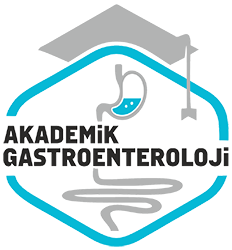Varis disi üst gastrointestinal sistem kanamali 412 olgunun irdelenmesi
Review of 412 patients with non-variceal upper gastrointestinal bleeding
Özet
Giriş ve amaç: Varis dışı üst gastrointestinal sistem kanamalari Gastroenteroloji Bilim Dali’nin en önemli acillerinden birisidir. Bu çalışmanın amacı varis dışı üst gastrointestinal sistem kanaması tanı si ile takip edilen olgularimizin özelliklerini değerlendirmektir. Gereç ve yöntem: Ege Üniversitesi Tıp Fakültesi Gastroenteroloji Klinigi’nde 1998-2005 yıllari arasında varis dışı üst gastrointestinal sistem kanaması nedeniyle izlenmis olan 412 olgu demografik özellikleri, etyolojileri, tedavileri ve sonlari yönünden retrospektif olarak değerlendirilmıştır. Bulgular: 311’i erkek (%75), 101’i (%25) kadın olan olgularin yaş ortalaması 62 (19-101) idi. Olgularin 136’sinin (%33) nonsteroid anti-inflamatuvar ilaç, 103’ünün (%25) aspirin, 20’sinin (%6) antikoagulan ilaç kullandigi saptanmıştır. Olgularin 397’sine (%96.4) endoskopik tetkik uygulanmıştır. En sık rastlani- lan kanama nedenleri olarak duodenum ülseri (175 hasta, %42.5), mide ülseri (95 hasta, %23.1), eroziv gastrit (29 hasta, %7.1) ve anastomoz ülseri (23 hasta, %5.6) bulunmustur. Toplam olarak 8 hasta (%2) kaybedilmıştır. Sonuç: Varis dışı üst gastrointestinal sistem kanama etyolojisi olarak En sık duodenal ülser saptanmıştır. Varis dışı üst gastrointestinal sistem kanamalarinda endoskopik tedavi basarimiz literatür ile benzerlik göstermektedir.
Abstract
Background/aims: Non-variceal upper gastrointestinal bleeding is one of the most common medical emergencies in the gastroenterology section. The aim of this study was to evaluate the characteristics of our patients with non-variceal upper gastrointestinal bleeding. Materials and methods: Four hundred and twelve patients who presented with non-variceal upper gastrointestinal bleeding and were admitted to Ege University Gastroenterology Department between 1998-2005 were retrospectively analyzed with respect to demographic data, etiology, treatment and outcome. Results: There were 311 (75%) male and 101 (25%) female patients with an average age of 62±18 (19-101). Of the patients, 136 (33%) had been using a nonsteroidal anti-inflammatory drug, 103 (25%) had been using aspirin, and 20 (6%) had been using an anticoagulant drug. Upper endoscopy was performed in 397 (96.4%) of the patients. The most common causes of bleeding were duodenal ulcer (175 patients, 42.5%), gastric ulcer (95 patients, 23.1%), erosive gastritis (29 patients, 7.1%), and anastomotic ulcers (23 patients, 5.6%). Overall, 8 (2%) patients died. Conclusions: Duodenal ulcer was the most common cause of non-variceal upper gastrointestinal system bleeding. Our success rate of endoscopic therapy for non-variceal upper gastrointestinal bleeding is similar to that in the literature.



